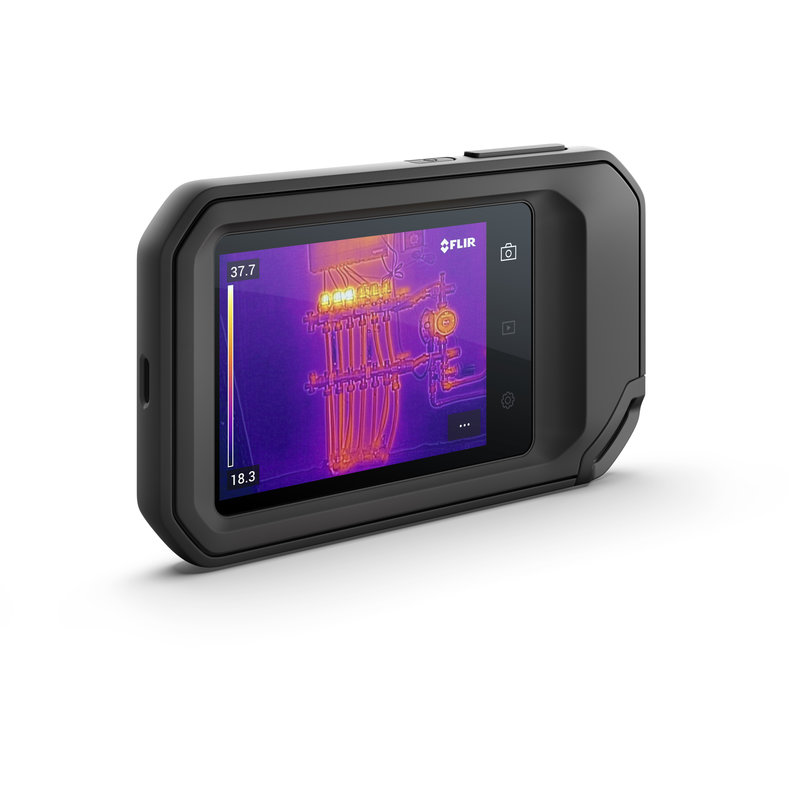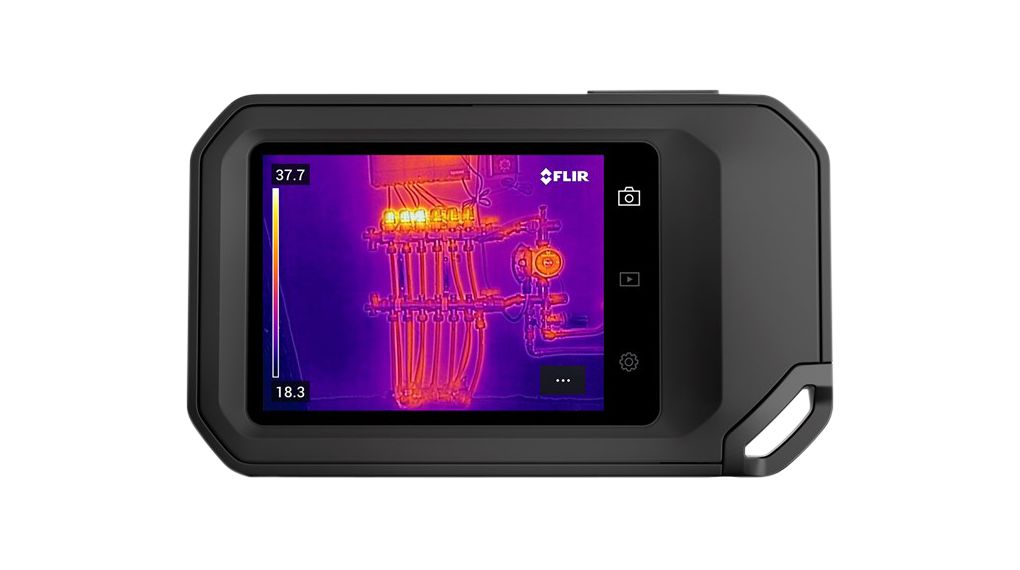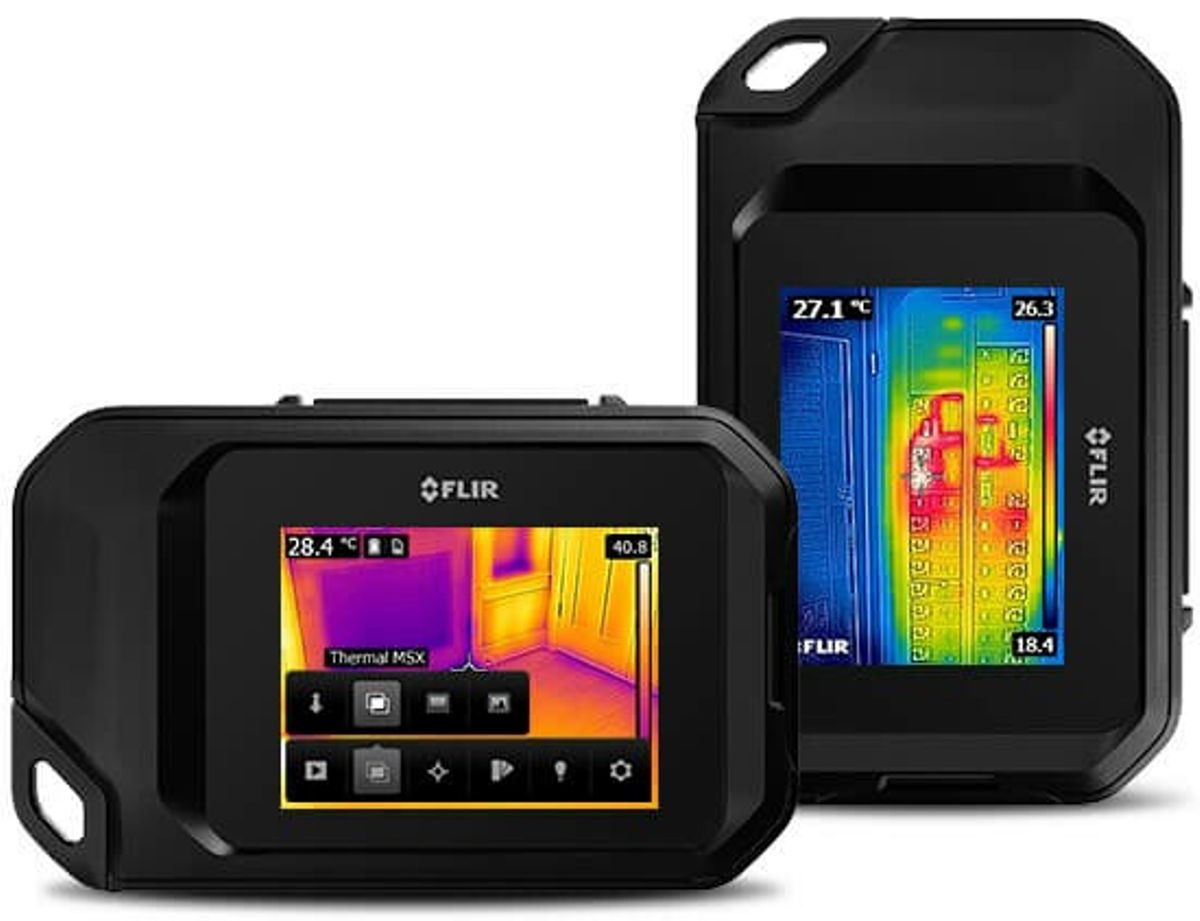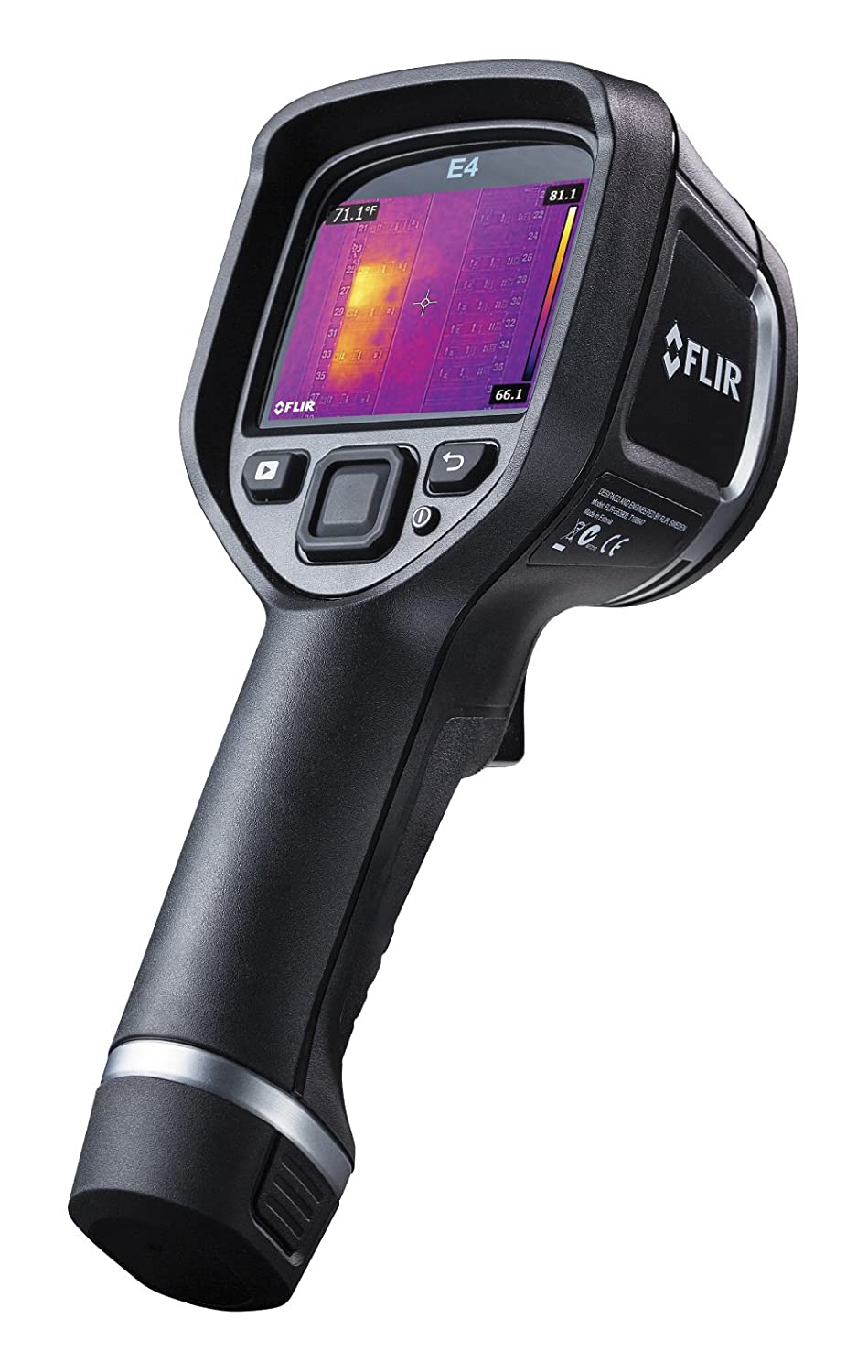In this thermal camera comparison, we will review and point out the differences between the Flir C2 vs Flir C3 vs Flir C3-X vs Flir C5 vs E4
We will be comparing them on all aspects, from image resolution, connectivity, picture quality and temperature measurement performance.
We will be comparing them on all aspects, from image resolution, connectivity, picture quality and temperature measurement performance.

| Product | Type | Resolution | Battery capacity | Waterproof | LCD screen | Price |
|---|---|---|---|---|---|---|
FLIR C5  | Handheld | 160 x 120 | 4 hours | Yes | 3.5″ | Click for more info |
Flir C2  | Handheld | 80×60 | 2 hours | No | 3″ capacitive | Click for more info |
FLIR C3  | Handheld | 80 x 60 | 2 hours | No | 3″ | Click for more info |
Flir C3-X  | Handheld | 128 x 96 | 4 hours | Yes | 3.5″ | Click for more info |
FLIR E4 Compact  | Handheld | 80 x 60 | 4 hours | No | 3″ | Click for more info |
Let’s have a look at each product in particular.
FLIR C5
| Product | Type | Resolution | Battery capacity | Waterproof | LCD screen | Price |
|---|---|---|---|---|---|---|
FLIR C5  | Handheld | 160 x 120 | 4 hours | Yes | 3.5″ | Click for more info |
The Flir C5 has an infrared sensor with a 160 x 120 thermal resolution just like the Flir One Pro thermal camera for smartphones and alongside it, there is a visual camera together with an LED light and the images from the two sensors are combined using the MSX Multi Spectral Dynamic Imaging software. Multispectral Dynamic Imaging MSX is the best image enhancement technology found on compact thermal imaging cameras. In terms of value, you do get more thermal pixels than you would in some of the EX series infrared cameras with MSX like the Flir E5 or Flir E5-XT.
The C5 can measure temperatures between -4 to 752°F (-20 to 400°C) with an accuracy of +/- 3 C and a thermal sensitivity of 0.05°C, making it not the most accurate camera here but certainly the one with the finest sensitivity.
It has USB connectivity to download the images to your computer, but that’s not the best feature. Its best feature is actually the Wi-fi connectivity through which it can upload the images automatically to the Flir Ignite cloud, a first of its kind. This isn’t just an infrared thermometer because these images are captured in JPG format with radiometric thermal data embedded in them, meaning you can measure the temperature in every pixel unlike spot thermal cameras which only store the center spot temperature and also change the color palette later or do measurements.
The camera lets you switch between image modes, you can choose to have either the visual or thermal image in view, then there is the MSX option which blends them together nicely and a Picture-In-Picture option too.
The Level / Span function is something we found very useful because it lets you tap on an object and highlight it.
The 3.5″ LCD touchscreen is large and responsive and the entire enclosure has an IP54 rating, meaning it is waterproof to the extent that you can splash it with water but cannot immerse it and it is also dustproof with a 2-meter drop durability. The battery lasts for a full 4 hours before you have to recharge it. And the best thing? Because it’s connected to the Cloud, that means OTA Over-The-Air firmware updates.
Flir C2
| Product | Type | Resolution | Battery capacity | Waterproof | LCD screen | Price |
|---|---|---|---|---|---|---|
Flir C2  | Handheld | 80×60 | 2 hours | No | 3″ capacitive | Click for more info |
Both devices come with a visible light camera and IR sensor and will offer the MSX image enhancement module.
The Flir C2 has a lower IR resolution than the C5 with just 80 x 60 pixels (Equivalent to a Flir TG165) while the C5 outputs 160 x 120. If you do the maths, you’ll find that the C5 provides 4 times more pixels.
The C2 has just a micro USB port while the C5 has USB and Wi-fi connectivity together with the cloud link. The temperature range on the C5 is much wider, because the C2 can only measure hot spots and cold spots between 13 ->302°F( -10 to 150°) while the C5’s range spans between -4 to 752°F (-20 to 400°C).
In terms of accuracy what is interesting is that the C2 according to Flir’s datasheet has a higher accuracy of +/-2 °C while the C5 provides a +/- 3 C accuracy. We haven’t tested both claims but are a bit skeptical of this regression in the newer model.
But things start to look again better with the C5 when you look at the temperature sensitivity which is 0.05 for the C5 and 0.10 for the Flir C2.
The C5 has a 4-hour battery life instead of just 2 hours, but it doesn’t have an SD card slot anymore, just an internal memory that can store up to 5000 images, while the C2 has the SD Card slot. The Flir C5 is also waterproof and dustproof with an IP54 rating while the C2 is not and the color display screen is bigger at 3.5″ instead of 3″ on the C2.
FLIR C3
| Product | Type | Resolution | Battery capacity | Waterproof | LCD screen | Price |
|---|---|---|---|---|---|---|
FLIR C3  | Handheld | 80 x 60 | 2 hours | No | 3″ | Click for more info |
The Flir C3 pocket thermal camera, like the C2 only has a 80 x 60 IR resolution compared to 160 x 120 on the C5, both devices have USB cable and Wifi connectivity, but the C5 has the additional cloud integration. The temperature range on the C5 spot thermal imaging camera is much wider at -4 to 752°F (-20 to 400°C) compared to just 13 ->302°F(-10 to 150°) on the C2.
Same thing with sensitivity, the C2 compact thermal camera has just a 0.10 C sensitivity compared to 0.05 for the C5. Both cameras have an internal memory, but the C5 can hold 5000 images while the Flir C2 can only hold 500. The battery life has also doubled on the C5 at 4 hours instead of 2. The Flir C5 is also waterproof and dustproof with an IP54 rating and has a larger LCD screen size with a 3.5″ diagonal.
Both devices have a visual camera and Infrared sensor and offer MSX technology. The C3 thermal imaging system doesn’t have the OTA firmware updates, the Cloud function or the Level / Span function.
Flir C2 vs Flir C3
The competition between these two infrared cameras is tighter.The Flir C3 thermal camera has additional wireless connectivity so you can connect to it using your smartphone and the Flir Tools app in the form of Wi-Fi, but in terms of memory it lacks the SD card slot and instead has an internal memory that can hold at least 500 thermal images.
Both IR Cameras have the same thermal resolution of 80 x 60, the same thermal sensitivity, refresh rate and measurement accuracy.
Like all Flir Cameras, they come with a 1-year warranty as standard that extends to 2 years for the devices themselves and 10 years for the thermal sensors if you complete the product registration process.
They might not be the newest thermal vision cameras, but rest assured that they will prove to be highly capable in most applications like building inspections, plumbing, HVAC, home inspections or checking electrical wiring.
Flir C3-X
| Product | Type | Resolution | Battery capacity | Waterproof | LCD screen | Price |
|---|---|---|---|---|---|---|
Flir C3-X  | Handheld | 128 x 96 | 4 hours | Yes | 3.5″ | Click for more info |
We’re going to compare it to the two relevant models, the Flir C3 which is its predecessor and the Flir C5 which is the only pocket camera in the line-up that is still officially being sold by Flir.
Flir C3-X vs Flir C3
There are several key differences between the Flir C3 and Flir C3-X models and the main one is the thermal resolution: The C3-X offers an improved 128 x 96 infrared resolution while the C3 only has an 80 x 60 resolution, so the newer model has about 2.5x times more thermal pixels.If we look at the C3-X vs C3 in terms of connectivity, we’ll notice that two things have changed with the C3-X: They added Bluetooth PAN connectivity and the Wi-fi now has Cloud support, thus becoming the second thermal camera to get access to the Flir Ignite platform. It can sync all the captured thermal images in the Cloud and you should get 1GB of storage like you get with the C5.
But things are not just better on the cloud storage side, because the internal memory is now guaranteed to hold at least 5000 thermal images compared to the 500 you used to get with the old Flir C3.
The temperature range that the C3-X can measure is also almost twice as wide from -4 F to 572 F (-20 C to 300 C) compared to the C3 which can only go from 13 to 302°F(-10 to 150°) and the thermal sensitivity has improved on the C3-X to 0.07 C.
Then there is the outside of the camera which was improved because now the C3-X’s enclosure is IP54 rated for being waterproof and dustproof. The old Flir C3 did not have any kind of water or dirt protection.
Then there is the battery life which has doubled and now the battery lasts 4 hours on the C3-X instead of just 2 and the touchscreen is bigger with a 3.5″ size instead of just 3″ on the C3. With all these updates, the C3-X offers much better value than the older model given that it is priced more or less the same.
Flir C3-X vs Flir C5
So how does the new Flir C3-X compare to the Flir C5?The C5 offers a better 160 x 120 pixels thermal resolution, so about 50% more detail in the image. The temperature range is also wider on the Flir C5 ranging from -4 to 752°F (-20 to 400°C), so you get 100 Celsius extra on the high end of the spectrum.
From here on the differences are more subtle: The Flir C5 has 1-touch Level / Span where you can tap on an object to highlight it, while the C3-X doesn’t have that feature. The C5 also offers 2 extra color palettes: Lava and Arctic.
They are both IP54 rated, both have Cloud connectivity and store the JPG images in radiometric form.
FLIR E4 Compact
| Product | Type | Resolution | Battery capacity | Waterproof | LCD screen | Price |
|---|---|---|---|---|---|---|
FLIR E4 Compact  | Handheld | 80 x 60 | 4 hours | No | 3″ | Click for more info |
Let’s have a look at the Flir E4 vs Flir C2. While they may have the same IR Resolution and MSX technology (something that is available on most Flir thermal imaging cameras), the same type of USB connectivity, the Flir e4 compact thermal imaging camera has a wider temperature measurement range between -4° F to 482°F (-20° to 250°C). Also, even though the thermal resolution is identical, the E4 just seems to have better picture quality during use.
The E4’s rechargeable battery lasts for 4 hours instead of just 2 and has an internal memory instead of the SD Card slot you find on the C2. The E4 also has the 3″ screen, but given that it has the handheld form factor, that is impressive.
The Flir E4’s field of view is much wider with a 56° x 42° viewing angle compared to the C2’s 41° x 31°.
Flir E4 vs Flir C3
In the Flir C3 vs Flir E4 comparison, the first thing you’ll notice is that the C3 is a thermal camera with wifi, while the E4 only connects via USB cable. The downside is that the C3 cannot stream video over wifi, both of these Flir Thermal Imagers are only capable of video streaming via USB cable.Both cameras have the same IR resolution, fixed internal memory and accuracy. The Flir E4 has a 0.15 sensitivity instead of 0.10 on the C3.
The E4 has become deprecated and is now replaced by the new Flir EX series models like the Flir E6-XT and Flir E8-XT professional thermal cameras.
Flir also builds other powerful tools that can complement your toolbox like the Flir MR160 and Flir MR176 thermal imaging moisture meters
Our Score
